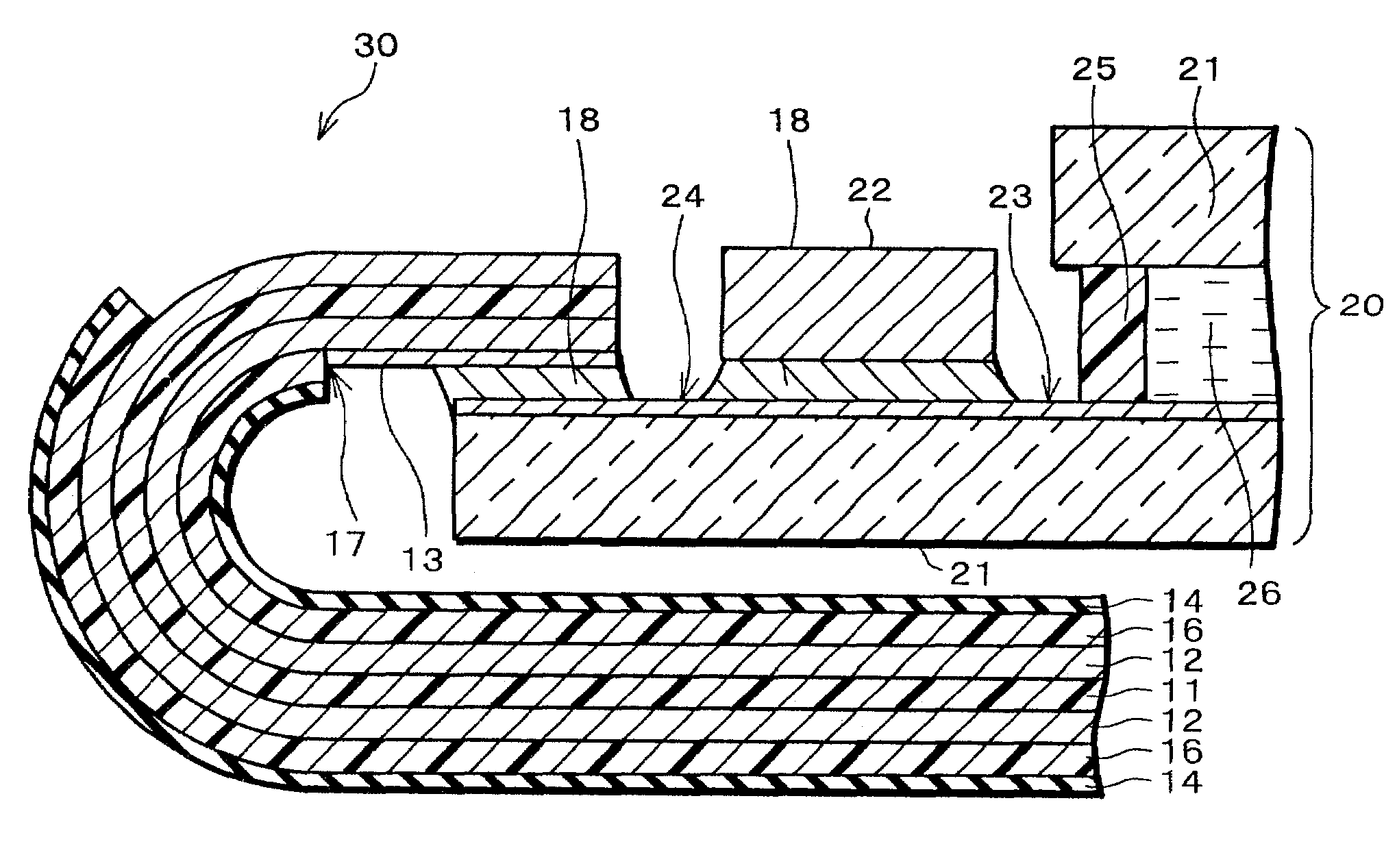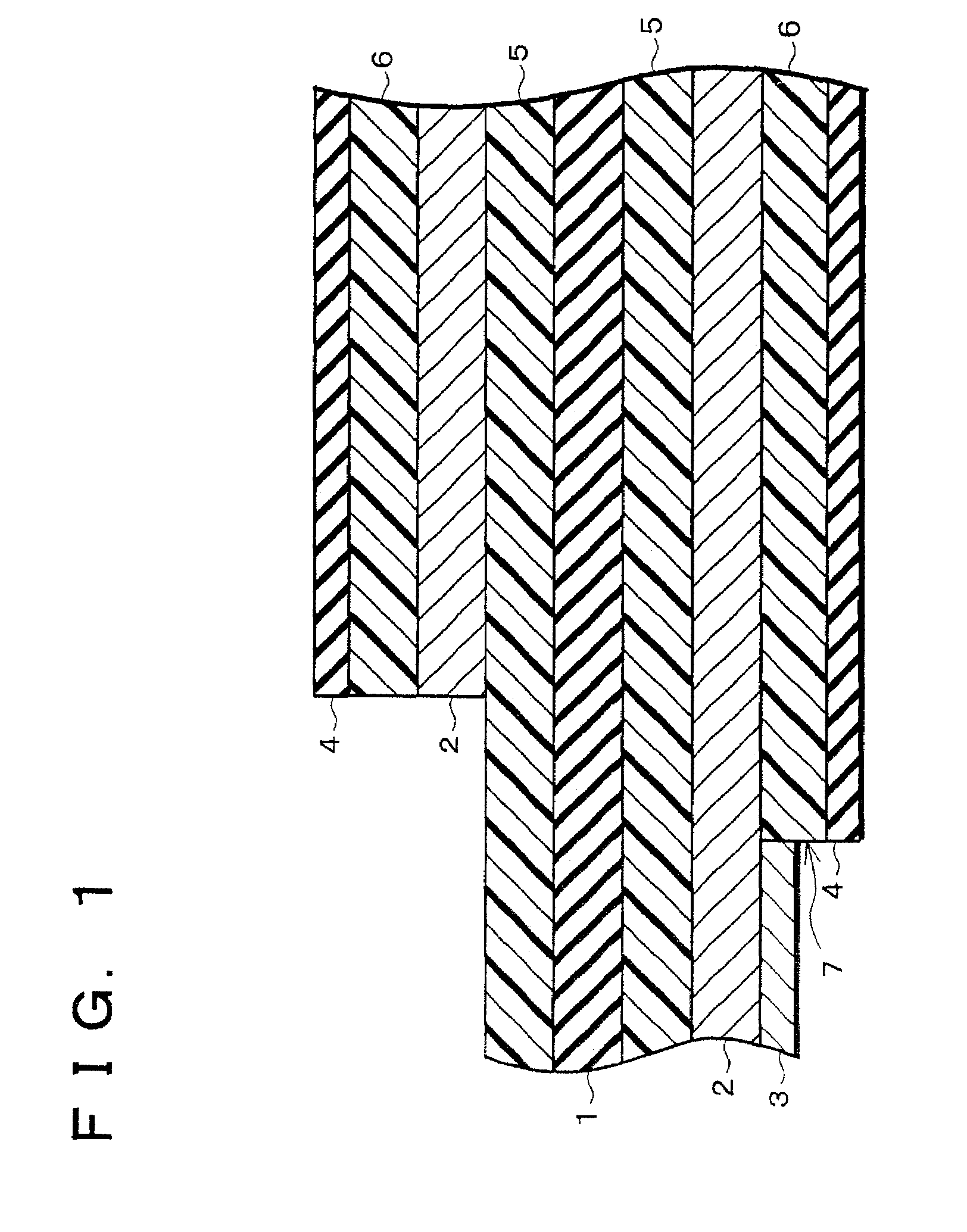Flexible wiring board and electrical device using the same
a flexible wiring board and electrical device technology, applied in the field of flexible wiring boards, can solve the problems of conventional flexible wiring boards, low yield of liquid crystal display devices, and easy wire breakage of copper foil patterns, and achieve the effect of preventing wire breakage and superior reliability
- Summary
- Abstract
- Description
- Claims
- Application Information
AI Technical Summary
Benefits of technology
Problems solved by technology
Method used
Image
Examples
first embodiment
[0048]The following will describe one embodiment of a flexible wiring board in accordance with the present invention referring to FIG. 1 which shows a cross section of the flexible wiring board. As shown in FIG. 1, the flexible wiring board of the present embodiment includes a base polymer film made of polymer (flexible insulating substrate) 1, and copper foil patterns (wiring) 2 which are bonded on the both sides of the base polymer film 1 by copper foil adhesive layers 5, respectively.
[0049]The material of the base polymer film 1 is not particularly limited, but polyimide, which has superior flexibility and superior heat resistance, is preferable. The thickness of the base polymer film 1 is generally set within a range of 12.5 μm to 75 μm, for example, at 12.5 μm, 25 μm, 50 μm, or 75 μm. Base polymer film 1 thinner than 12.5 μm is difficult to handle and thus difficult to manufacture. The thickness of base polymer film 1 exceeding 50 μm is not preferable because the flexibility of...
second embodiment
[0076]The following will describe a Second Embodiment of the present invention referring to the drawings. Note that, for convenience of explanation, elements having the same functions as those described in the First Embodiment are given the same reference numerals and explanations thereof are omitted here.
[0077]As shown in FIG. 3, a flexible wiring board 30 of the present embodiment is the same as the flexible wiring board 10 of the First Embodiment except that it is an adhesive-less flexible wiring board where the base polymer film 11 and the copper foil pattern 12 are directly bonded to each other without using the copper foil adhesive layer 15. In this case, the copper foil pattern 12 is formed, for example, by the method in which a copper foil is pressure-welded with the base polymer film and thereafter the copper foil is wet-etched.
[0078]As shown in FIG. 3, the flexible wiring board 30 is connected to an end portion on the upper surface of a larger glass substrate 21 (glass sub...
third embodiment
[0087]The foregoing embodiments described the flexible wiring boards having copper foil patterns on the both surfaces; however, a flexible wiring board having the copper foil pattern only on one surface can also be effected.
[0088]Thus, the following will describe another embodiment of the present embodiment referring to FIG. 4 employing a flexible wiring board having the copper foil pattern only on one surface. Note that, for convenience of explanation, elements having the same functions as those described in the First Embodiment will be given the same reference numerals and explanations thereof are omitted here.
[0089]As shown in FIG. 4, a flexible wiring board 40 of the present embodiment is the same as the flexible wiring board 10 of the First Embodiment except it does not include the copper foil adhesive layer 15, copper foil pattern 12, insulative protecting film adhesive layer 16, and insulative protecting film 14 on the outer side of the bend (upper side in FIG. 4) of the flex...
PUM
| Property | Measurement | Unit |
|---|---|---|
| thickness | aaaaa | aaaaa |
| thickness | aaaaa | aaaaa |
| thickness | aaaaa | aaaaa |
Abstract
Description
Claims
Application Information
 Login to View More
Login to View More - R&D
- Intellectual Property
- Life Sciences
- Materials
- Tech Scout
- Unparalleled Data Quality
- Higher Quality Content
- 60% Fewer Hallucinations
Browse by: Latest US Patents, China's latest patents, Technical Efficacy Thesaurus, Application Domain, Technology Topic, Popular Technical Reports.
© 2025 PatSnap. All rights reserved.Legal|Privacy policy|Modern Slavery Act Transparency Statement|Sitemap|About US| Contact US: help@patsnap.com



